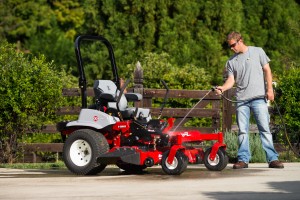Proper winter storage for your lawn mower is essential if you want to protect your investment over the long-term. Any period of inactivity can be bad for mechanical equipment—add in the effects of cold weather on machinery, and you can see why you should take the time to properly maintain and store your mower.
Whether you have a single push mower, a riding mower, or an entire fleet of zero-turn mowers, here are the basic steps you should follow.
Fully Clean Your Mower

Cleaning your mower is important before storing. Keeping the mower clean from accumulated debris helps prevent moisture which can cause rust.
If you perform only one task in your winterizing prep, let it be a full cleanup of your equipment. Any debris left on the exterior or interior can result in moisture, which can cause rust or a freezing/thawing cycle that is bad for metal. Take any normal steps you would to clean your equipment, including spraying the deck out, removing blades, scraping out clumps of grass, and other wipe-down steps. At the end, your machine should be free of any grass, clippings or dirt.
Regular Maintenance
The next step in your mower winterizing plan is to change the oil, the spark plugs, and/or the air filters. These types of activities should be a part of your regular maintenance plan anyway, so always schedule one after your final run. You should also either empty out the fuel system or add a fuel stabilizer designed for winter storage. For more comprehensive maintenance care, you can also lubricate all points of friction.
Once these updates have been made, we suggest you run the mower’s engine for a few minutes. This will allow you to ensure that everything has been changed properly and get the new fuel and additives into the mower’s system.
Prep the Battery
You have the option of either re-charging the battery throughout the winter months or removing it and storing it in a cool, dry place. Some people prefer to check on their equipment every month or so, firing it up so that it doesn’t sit too long in a garage or other storage area. In this instance, it’s okay to leave the battery in (although you should fully charge it first.) Others prefer to put their equipment away and forget about it until spring. Decide which approach is right for you.
Don’t Forget the Tires
If your mower has pneumatic tires, you should park on a surface that’s not cold concrete (a piece of cardboard over the surface will often do the trick). You should also rotate the tires throughout the winter season so they don’t bear too much pressure on one side.
Store the Mower
The final step in winterizing your equipment is to find a place to store it. A garage or other covered facility is best, as this will keep the cold out and ensure that no moisture gets in your equipment. A cover is ideal, as this will add extra protection against the elements. Keep the mower away from any appliance that can cause a spark. It’s also best to store your equipment away from fertilizer or any other corrosive materials, which eat away at the metal when airborne.
SHARE





